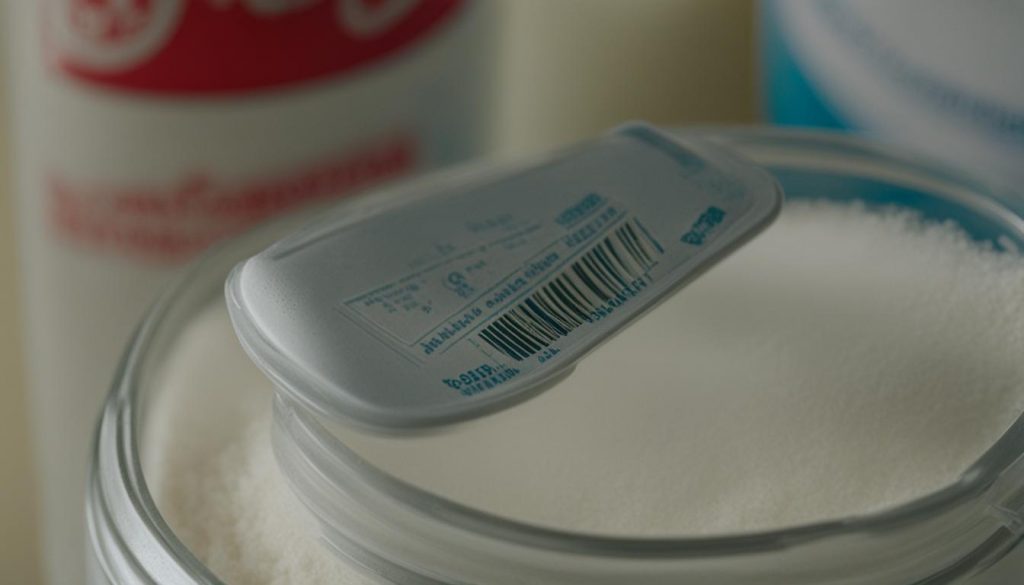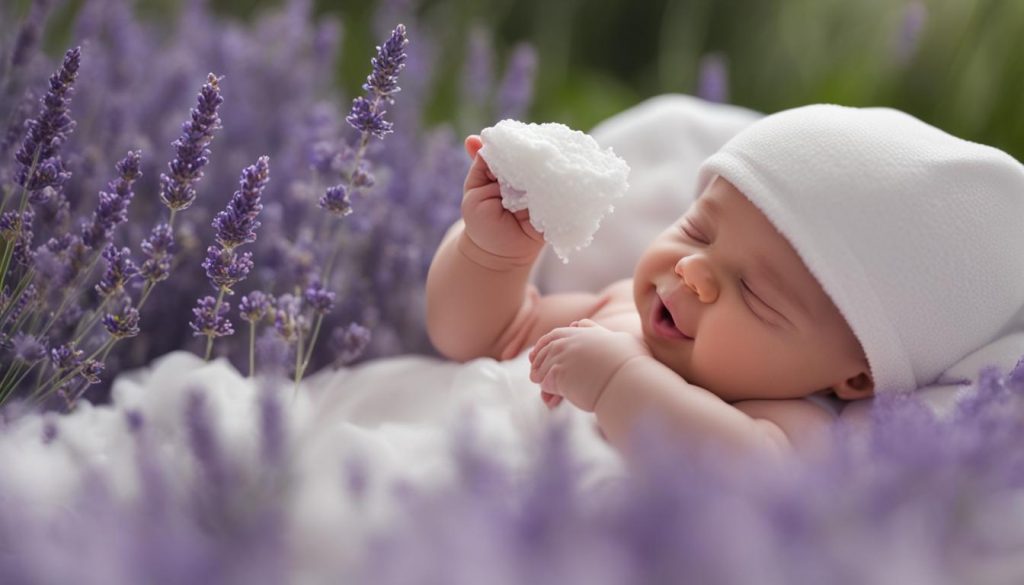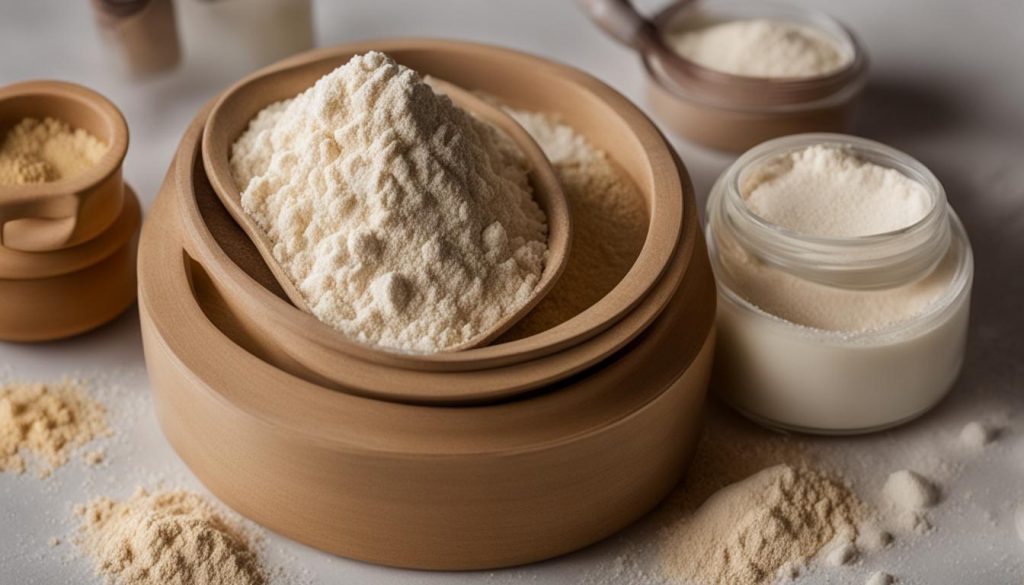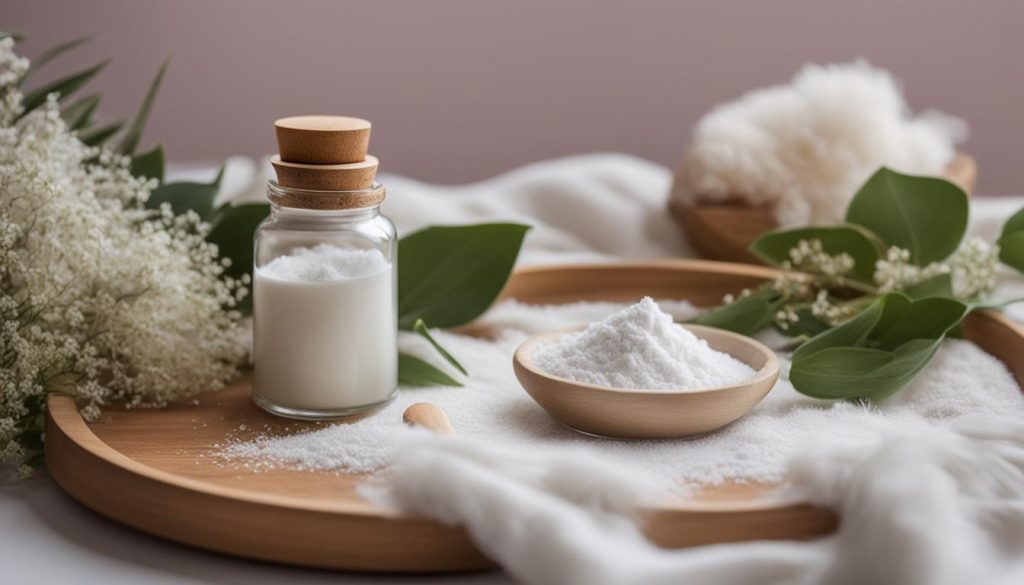As a parent, you want to ensure that the products you use on your baby are safe and effective. Baby powder is a popular choice for many parents, but have you ever wondered if it expires? Understanding the shelf life of baby powder is important to ensure its freshness and effectiveness. In this article, I will explore the expiration date of baby powder, how it works, and provide some alternative options for those who have concerns. So, let’s dive in and find out more!
Key Takeaways:
- Baby powder does have an expiration date, typically around 2-3 years from the manufacturing date.
- Proper storage is essential to extend the shelf life of baby powder.
- Expired baby powder may lose its effectiveness and can potentially cause skin irritation.
- There are alternative options available, such as cornstarch and arrowroot powder.
- It’s important to prioritize your baby’s safety and comfort when using any product.
What Is Baby Powder and How Does It Work?
Baby powder is a widely used product known for its ability to absorb moisture and reduce friction on the skin. It is typically made from either talc or cornstarch, both of which contribute to its moisture-absorbing properties. When applied to the body, baby powder forms a thin layer that helps keep the skin dry and comfortable, making it ideal for preventing diaper rash or reducing friction between body parts. The choice of talc or cornstarch as the main ingredient may depend on personal preference or specific skin sensitivities.
Talc, a mineral composed of magnesium, silicon, and oxygen, has excellent moisture-absorbing qualities and is often used in baby powder formulations. On the other hand, cornstarch, derived from corn kernels, has similar moisture-absorbing and friction-reducing properties. Some individuals may prefer cornstarch-based baby powders due to concerns over potential contamination of talc with asbestos, a known carcinogen. However, it is important to note that cosmetic-grade talc used in baby powders is required to be asbestos-free.
“Baby powder is a trusted product for keeping the skin dry and comfortable, thanks to its moisture-absorbing and friction-reducing properties.”
When applying baby powder, it is essential to gently shake the container to ensure an even distribution of the product. The powder can be gently patted or sprinkled onto the desired areas, such as the diaper area, underarms, or other areas prone to moisture buildup. It is important to avoid applying baby powder near the face, as inhaling the powder particles may pose respiratory risks. Additionally, it is crucial to store baby powder in a cool, dry place away from moisture and direct sunlight to maintain its quality and effectiveness.
Overall, baby powder is a versatile product that offers moisture absorption and friction reduction, making it a popular choice for various applications. Whether using talc-based or cornstarch-based baby powder, it is essential to follow proper application techniques and storage recommendations to ensure its effectiveness and safety.
How Is Baby Powder Used on Babies?
Baby powder is a versatile product commonly used in a baby’s daily hygiene routine. It serves multiple purposes such as preventing diaper rash, reducing friction, and keeping the skin dry. To use baby powder effectively, it is important to understand the proper application methods and areas where it can be applied.
One of the primary uses of baby powder is in the prevention of diaper rash. Before putting on a clean diaper, parents can sprinkle a small amount of baby powder on their baby’s bottom to absorb moisture and reduce irritation. This helps keep the diaper area dry and prevents the development of rashes.
In addition to the diaper area, baby powder can also be applied to other areas prone to moisture and friction. These include the feet, underarms, wrists, knees, ankles, and belly button. By applying a small amount of powder to these areas, parents can minimize the buildup of moisture and reduce friction, keeping the baby’s skin dry and comfortable.
Baby powder can also be used as a spot treatment for various skin conditions. If a baby gets insect bites or comes into contact with poison ivy, a small amount of powder can be applied to soothe the affected area. However, it is important to use baby powder sparingly and avoid direct inhalation to minimize any potential risks.
Table: Areas Where Baby Powder Can Be Applied
| Area | Application |
|---|---|
| Diaper Area | Apply a small amount before putting on a clean diaper to prevent diaper rash. |
| Feet | Sprinkle a small amount to absorb moisture and reduce friction. |
| Underarms, Wrists, Knees, Ankles | Apply to prevent moisture buildup and reduce friction. |
| Belly Button | Use to keep the area dry and prevent discomfort. |
When using baby powder on babies, it is important to remember that less is more. Applying a small amount and gently massaging it into the skin is usually sufficient. It is also advisable to choose baby powders that are free from added fragrances or irritants, as these can potentially cause skin allergies or reactions.
By understanding how to use baby powder properly and applying it in the appropriate areas, parents can effectively prevent diaper rash, reduce friction, and keep their baby’s skin dry and comfortable.
Types of Baby Powder: Talc-Based vs. Corn Starch
When it comes to choosing a baby powder, it’s essential to understand the different types available and the safety concerns associated with them. The two primary options you’ll come across are talc-based baby powder and corn starch baby powder.
Talc-based baby powders have been popular for years due to their excellent moisture absorption properties. However, recent safety concerns have arisen regarding the potential contamination of talc with asbestos, a known carcinogen. As a result, many parents are now seeking safer alternatives.
Corn starch baby powder is considered a safer choice. It is hypoallergenic and free from potential asbestos contamination. The fine particles of corn starch help absorb moisture and reduce friction on the skin, providing a gentle and effective solution for diaper rash prevention and general hygiene.
| Talc-Based Baby Powder | Corn Starch Baby Powder |
|---|---|
| May be contaminated with asbestos | Hypoallergenic and asbestos-free |
| Excellent moisture absorption properties | Helps absorb moisture and reduce friction |
| Potential safety concerns | Safer alternative |
In addition to talc-based and corn starch baby powders, there are also organic alternatives available in the market. These powders are made from natural ingredients like corn starch, arrowroot powder, or kaolin clay, providing a chemical-free option for parents who prefer organic products.
When choosing a baby powder, it’s important to consider both the effectiveness and the safety of the product. Opting for talc-free or corn starch-based powders can help mitigate potential risks while still providing the benefits of moisture absorption and friction reduction.
The Expiration of Baby Powder
Baby powder, like any other product, has an expiration date. Most baby powders have a shelf life of around 2-3 years from the manufacturing date. It is important to check the packaging or container for the expiration date to ensure that the powder is still fresh and safe to use. Using expired baby powder may result in reduced effectiveness and changes in texture, which can affect its ability to absorb moisture and reduce friction.
Proper storage is crucial in maintaining the quality and shelf life of baby powder. It is recommended to store the powder in a cool, dry place away from moisture and direct sunlight. Exposure to heat and humidity can degrade the powder and shorten its shelf life. Additionally, keeping the packaging sealed and intact will prevent air and moisture from entering, helping to preserve the powder’s freshness and effectiveness.
When using baby powder, it is important to adhere to the recommended storage guidelines to ensure its longevity and efficacy. By following these storage recommendations, you can confidently use baby powder within its expiration date, knowing that it will continue to serve its intended purposes effectively.
Table: Recommended Storage Guidelines for Baby Powder
| Storage Recommendations | Do’s | Don’ts |
|---|---|---|
| Storage Location | Store in a cool, dry place | Avoid storing in the bathroom or areas with high humidity |
| Exposure to Sunlight | Keep away from direct sunlight | Avoid leaving it in a car or near windows |
| Seal Integrity | Ensure the packaging is sealed tightly | Do not use if the seal is broken or damaged |
“Using expired baby powder may result in reduced effectiveness and changes in texture, which can affect its ability to absorb moisture and reduce friction.”
“By following these storage recommendations, you can confidently use baby powder within its expiration date, knowing that it will continue to serve its intended purposes effectively.”
Using Expired Baby Powder: Is it Safe?
When it comes to using expired baby powder, it’s important to consider both its effectiveness and potential risks. While using expired baby powder may not pose immediate health hazards, it may have lost some of its efficacy over time. Additionally, expired baby powder can potentially cause skin irritation or worsen existing skin conditions. Therefore, it is generally recommended to avoid using expired baby powder and to dispose of it properly.
Expired baby powder may no longer effectively absorb moisture or reduce friction on the skin, which are the primary functions of this product. As a result, it may not provide the desired level of protection against diaper rash or other skin irritations. Using fresh, unexpired baby powder can help ensure its freshness and effectiveness in keeping your baby’s skin dry and comfortable.
Furthermore, expired baby powder may pose a higher risk of skin irritation. As the powder ages, its texture may change, becoming clumpy or lumpy, which can potentially aggravate the skin. This is especially true for babies with sensitive skin or pre-existing skin conditions. To avoid any potential discomfort or adverse reactions, it is best to use baby powder within its recommended shelf life.
In conclusion, while using expired baby powder may not have immediate adverse effects, it is better to err on the side of caution and avoid its use. By disposing of expired baby powder and purchasing a new bottle, you can ensure its freshness, efficacy, and avoid potential risks such as skin irritation or worsening of skin conditions.
Baby Powder Storage: Extending Shelf Life
Proper storage is crucial for maintaining the quality and effectiveness of baby powder. By following a few simple guidelines, you can extend its shelf life and ensure its freshness when you need it. One key aspect of storage is preventing moisture from reaching the powder, as dampness can compromise its texture and effectiveness.
To protect baby powder from moisture, store it in a cool, dry place away from any potential sources of water or humidity. Avoid storing it in bathrooms where steam and moisture are more prevalent. Additionally, make sure the packaging is intact and the seal is not broken. A tightly sealed container will help keep air and moisture out, preserving the quality of the powder.
Consider using an airtight container to store your baby powder. This extra layer of protection can further prevent moisture from seeping in and affecting the powder. It’s important to note that baby powder should be stored separately from other products, especially those with strong fragrances, to avoid any potential cross-contamination.
By following these storage recommendations, you can ensure that your baby powder remains fresh, effective, and ready for use when you need it most. Taking proper care in storing your baby powder helps maximize its shelf life and maintain its quality.
Alternatives to Baby Powder
While baby powder is a popular choice for many parents, there are alternatives available that can serve similar purposes and meet your baby’s needs. These alternatives provide moisture absorption and reduce friction, ensuring your baby’s comfort and well-being. Here are some alternatives to consider:
Cornstarch:
Cornstarch is a natural and widely available option that can be used as an alternative to baby powder. It has moisture-absorbing properties and helps keep the skin dry, making it effective for preventing diaper rash and reducing friction. Cornstarch is gentle on the skin and less likely to cause irritation, making it suitable for babies with sensitive skin.
Arrowroot Powder:
Arrowroot powder is another natural alternative that can be used in place of baby powder. It has similar moisture-absorbing properties to cornstarch and is known for its gentle and soothing effect on the skin. Arrowroot powder is hypoallergenic and can be a good option for babies with sensitive or irritated skin.
Talc-Free Products:
If you prefer a powder specifically formulated for babies but want to avoid talc-based options, there are talc-free baby powders available in the market. These powders are often made with natural ingredients like cornstarch, arrowroot powder, or other plant-based substances. They provide the same moisture-absorbing and friction-reducing benefits without the potential risks associated with talc.
When choosing an alternative to baby powder, it is essential to read the product labels and ingredients to ensure they are safe and suitable for your baby’s delicate skin. Consider consulting with your pediatrician or dermatologist for personalized recommendations based on your baby’s specific needs and any existing skin conditions.
| Alternative | Main Benefits | Considerations |
|---|---|---|
| Cornstarch | – Natural and widely available – Moisture-absorbing properties – Gentle on sensitive skin |
– Can be messy if not applied carefully |
| Arrowroot Powder | – Natural and soothing – Moisture-absorbing properties – Hypoallergenic |
– May not be as readily available as other options |
| Talc-Free Products | – Specifically formulated for babies – Safe and suitable for sensitive skin – Moisture-absorbing properties |
– Check for potential allergens in the ingredients |
Baby Powder Safety Concerns: Inhalation Risks, Skin Irritation, and Asbestos Contamination
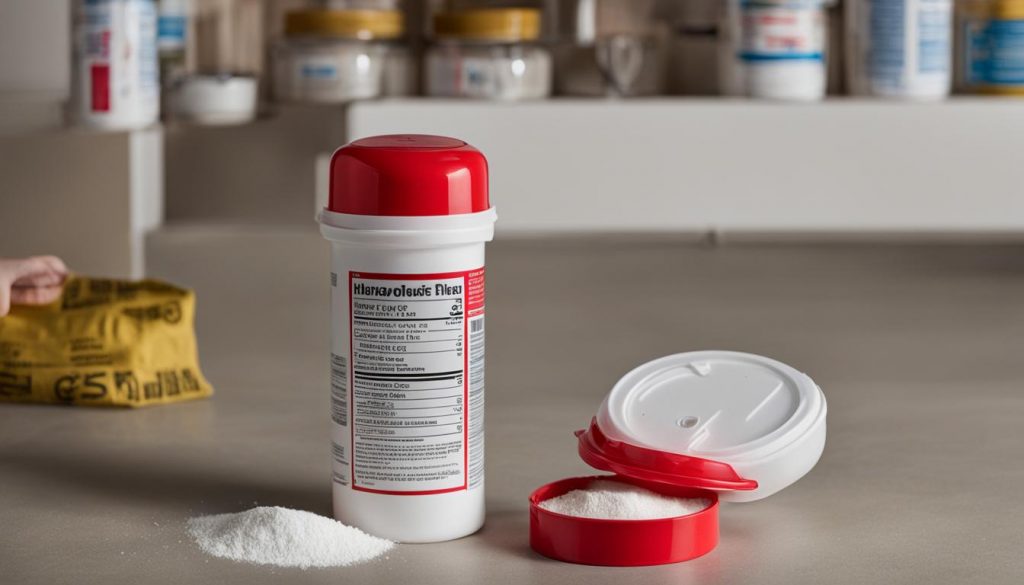
When it comes to using baby powder, it is important to be aware of certain safety concerns that have been associated with this product. While baby powder can be a helpful tool in maintaining infant hygiene, understanding the potential risks is crucial for making informed decisions.
Inhalation Risks
One of the main concerns with baby powder is the risk of inhalation. When the powder is applied or dispersed, it can become airborne, and inhaling the particles can pose respiratory risks. To prevent this, it is recommended to avoid direct application near the face and to be cautious when using it on babies with respiratory conditions. Additionally, it is advised to keep the room well-ventilated during application to minimize the risk of inhalation.
Skin Irritation
Another safety concern with baby powder is the potential for skin irritation. Some individuals may have sensitivity or allergies to certain ingredients in baby powder, which can lead to redness, itching, or rashes. It is important to carefully observe your baby’s skin after applying baby powder and discontinue use if any irritation occurs. Consulting with a pediatrician can also provide guidance on suitable alternatives if your baby has sensitive skin.
Asbestos Contamination
Talc-based baby powders have been associated with the risk of contamination with asbestos, a known carcinogen. Asbestos can occur naturally alongside talc deposits and may contaminate talc during the mining process. To address this concern, many manufacturers have transitioned to talc-free formulations or have implemented rigorous testing processes to ensure the absence of asbestos. It is essential to choose trusted brands that prioritize safety and quality control.
By being aware of these safety concerns, parents can make informed decisions when using baby powder. Following recommended guidelines, such as avoiding inhalation, monitoring for skin irritation, and choosing trusted brands, can help mitigate potential risks and ensure the well-being of your baby.
Conclusion
In conclusion, when it comes to baby powder, it is crucial to prioritize the safety and comfort of your little one. Understanding the expiration date and potential risks associated with expired baby powder is essential. While it may not pose immediate health concerns, using expired baby powder can result in decreased effectiveness and may even irritate the skin. Therefore, it is advisable to dispose of expired baby powder properly and purchase a fresh bottle.
Proper storage is key to extending the shelf life of baby powder. By keeping it in a cool, dry place away from moisture and direct sunlight, you can maintain its quality and effectiveness. Make sure the packaging is intact and the seal is not broken to prevent moisture and air from entering the container. To further ensure freshness and texture, consider storing baby powder in an airtight container.
If you have concerns about using baby powder, there are alternatives available. Cornstarch and arrowroot powder are natural alternatives that can effectively absorb moisture and reduce friction. Additionally, there are talc-free powders specifically designed for babies with sensitive skin. Before making a choice, it is crucial to read the ingredients and select products that are safe and suitable for your baby’s needs.
In summary, baby powder can be a beneficial product for maintaining infant hygiene. By understanding the expiration date, potential safety risks, and alternative options, you can make informed decisions about its usage. Remember to prioritize your baby’s safety and comfort at all times, including proper storage and handling of baby powder.
FAQ
Does baby powder expire?
Yes, baby powder does have an expiration date. Most baby powders have a shelf life of around 2-3 years from the manufacturing date.
What is baby powder and how does it work?
Baby powder is a mixture of talc or cornstarch designed to absorb moisture and reduce friction on the skin. Talc helps absorb moisture, while cornstarch acts as an antibacterial agent.
How is baby powder used on babies?
Baby powder is typically applied to areas such as the feet, underarms, wrists, knees, ankles, and belly button to prevent moisture buildup, reduce friction, and keep the skin dry.
What are the types of baby powder: talc-based vs. corn starch?
Baby powders are available in talc-based and corn starch-based formulations. Talc-based powders have safety concerns due to potential contamination with asbestos, while corn starch-based powders are considered safer alternatives.
How long does baby powder last?
Baby powder typically has a shelf life of around 2-3 years from the manufacturing date.
Is it safe to use expired baby powder?
While using expired baby powder may not pose immediate health risks, it may lose its effectiveness and potentially cause skin irritation. It is generally recommended to avoid using expired baby powder and to dispose of it properly.
How should baby powder be stored to extend its shelf life?
Baby powder should be stored in a cool, dry place away from moisture and direct sunlight. Keeping the packaging intact and the seal unbroken can help maintain its freshness and effectiveness.
What are the alternatives to baby powder?
Cornstarch and arrowroot powder can be used as natural alternatives to absorb moisture and reduce friction. Many brands also offer talc-free powders specifically designed for babies with sensitive skin.
What are the safety concerns with baby powder?
Baby powder, especially talc-based powders, has been associated with safety concerns such as inhalation risks, skin irritation, and potential contamination with asbestos. It is important to be aware of these risks and make informed choices.
Conclusion
Understanding the expiration date, proper storage, and potential safety risks of baby powder is essential for ensuring its effectiveness and your baby’s safety. Consider alternatives and prioritize your baby’s comfort and well-being when using any product, including baby powder.

